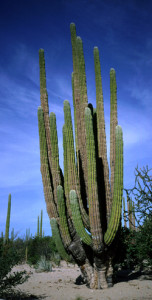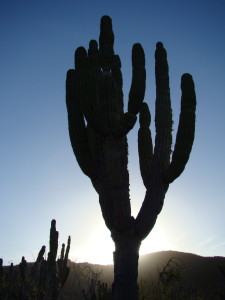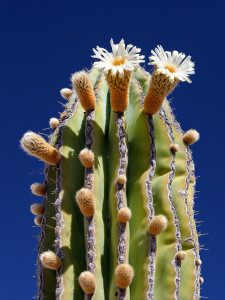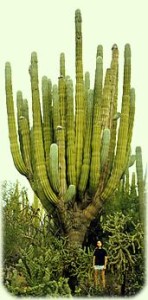Standing like guardians of an ancient time, the mighty cardón cacti are a reminder that Todos Santos sprung out of a venerable desert. This cactus has been a subject of artists, photographers, and poets for many years and for many good reasons. Nothing quite aches in a wanderlust soul like seeing the silhouette of a lonely cardón against the sky of a Baja sunset. One walk through the galleries of Todos Santos and you will see how many paintbrushes have tried to capture these amazing giants in all their glory.
Pachycereus pringlei, or what we refer to as the Mexican cardón, has an interesting relationship to insure its survival in the dessert conditions. A symbiotic relationship with bacterial and fungal colonies on its roots allows the cardón to grow on essentially bare rock even where no soil is available at all, as the bacteria can fix nitrogen from the air and break down the rock to produce nutrients. Even the seeds of this cactus packages symbiotic bacteria. These cacti have a few other desert survival tricks up their spiny sleeves. It possesses an extensive, shallow root systems which quickly capture the brief, but torrential rains of the region. A large cardón may store over a ton of water in the fleshy, pulp-like tissues of its trunk. In order to support this considerable weight, the immense cactus has an interior framework of hardwood vertical rods, lightweight, yet extremely strong, which act to stiffen the ribs.
The cactus is sometimes mistaken with the saguaro cactus (Carnegiea gigantea). However, the saguaro is not found in Baja and while the saguaro is an impressive cactus as well it does not hold the title the cardón holds as the world’s largest cactus. How large? Muy grande! Some of the largest have been measured at nearly 21 meters (70 feet) high and weigh up to 25 tons. The majestic trunk of these cactus can be bigger than a compact car at 5 feet in diameter.
From March through June, flowers appear on the topmost tips of stems, especially stems with warm, southern exposure. You might be intrigued during an afternoon walk in the desert surrounding Todos Santos as these flowers open at that time. They stay open all night, then close about mid-morning the next day. As a cactus why show off your flowers at night? Well, these goliath plants rely on the winged travels of desert bats to visit with their appetite for nectar at that time. Bats are the primary pollinator for the cardón. The bat visits and thrusts its head down into the bell shaped tube of the flower, lapping the nectar from the tube with its long tongue. The large amount of pollen on the rim and sides of the tube sticks readily to the fur of the bat’s face and head. The actual feeding visit lasts less than a second. When the bat visits the flower on another plant, cross pollination occurs.
This towering cactus has a few main threats, all of which come from encroaching human populations. Overgrazing by cattle, clear cutting, and even being used as target practice to name a few. Thoughtful development of desert land can do much in securing that these beautiful staples of Baja life can thrive.
Probably one of the most haunting feelings of being close to this colossus cactus, is knowing its lasting age. The cardón has a longer life span than us humans at over 300 years. So next time you wander the beautiful deserts that fringe Todos Santos ponder that some of these cacti were here long before any of us and have seen all that has to be seen here in our Baja home.




